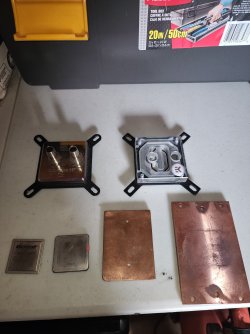No, it makes it possible to respond to individual statements so that things are at least moderately readable, unlike this wall of spaced-out sentences you've posted here.
Okay, I had a long answer here, but reading to the end of your post has made it abundantly clear to me that we're not discussing the same thing. You've been working off of radically different assumptions for what is being discussed here, and arguing against my statements about a given platform with statements that assume every single variable is up for discussion. It isn't. Yes, there is a relation between die size, IHS size, and IHS thickness. For a given platform, IHS size is fixed, as it's determined by the socket and package dimensions (with maybe a mm or two of leeway for tweaking the design in X and Y directions. So: the area of the IHS for any given platform is fixed, and not up for discussion - at least unless it's brought up at the beginning of the damn discussion. Which you didn't. You responded to me saying the IHS was too thick by arguing that no, a thicker IHS would be better. Which ... no. Just no.
The question I've been trying to discuss with you this whole time has been this: given the size of AM5 heatsinks, assuming a cooler designed for the platform, would it be better with a thinner IHS? This is what I have argued for. Neither more nor less. You've come here dragging in all kinds of absurd examples, which are entirely irrelevant to this discussion. If you have been trying to argue this whole time that the fundamental characteristics of the platform are wrong, then why didn't you say so? It is so utterly and completely frustrating to try have a discussion with someone who doesn't even try to clarify the parameters of what they're discussing. This is also why you've been constantly contradicting yourself in all kinds of ways: because you've been responding to my arguments that presuppose that all other factors are pre-given with statements that assume that everything is in flux, making your logic fundamentally inapplicable to the question at hand.
To sum up: for any given surface area, a thinner IHS is better, assuming it has sufficient thickness to be mechanically stable and isn't so thin as to entirely hinder spreading heat outwards (which generally overlaps with mechanical stability - an IHS so thin as to stop heat spreading outwards sufficiently would also bend under pressure). Which I have come to believe that you agree with.
Whether the AM5 socket should have had a larger IHS is an entirely different discussion.
Why on earth are you linking garbage rumor mill site WCCFtech instead of Der8auer's video for this? You prefer to use a secondary source notorious for terrible analysis rather than the original source? Cool.
Jesus, have you read anything that has been posted in all the various 7000-series threads? CPU core temperature does not equal heat exhausted into your room. Power draw equals heat exhausted into your room. The absolute temperature of your CPU is not directly tied to the amount of heat energy put out by the system - if it was, then you wouldn't be able to lower temperatures with better cooling on any CPU ever.
The absolute temperature of the CPU is a function of power consumption and how quickly the cooling setup (TIM, IHS, TIM, cooler, ambient air temp) is able to move heat away from the core.
The heat output into ambient air is a function of the power consumption of the core. Period. If your CPU is consuming 230W consistently, then 230W of heat energy is being dumped into your room, regardless if the CPU cores are 30°C or 95°C.
That's what Eco mode is for. IMO, that should have been the default setting for these CPUs, but sadly the competitive situation makes things different right now.
It takes quite a lot of effort to scratch through a nickel plating. It's not tin foil.




